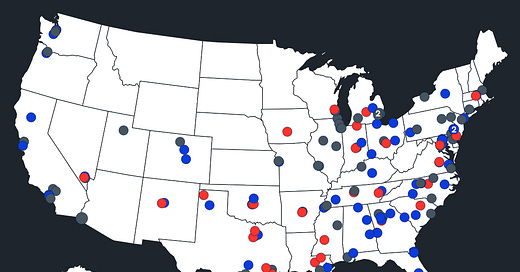Gunfire at schools increased 31% last school year: Collaboration with Everytown
Gun Violence Is Down in Our Cities. Why Not Also in Our Schools?
There are many different efforts to track gun violence at schools and continued disagreement over the basic definition of a “school shooting” (see: Episode 6: What is the definition of a 'school shooting' and why does it matter?)
For the last few years, I’ve worked with Everytown’s research team to help unify our efforts to track school shootings (see: Gunfire on School Grounds in the United States). I helped publish new study last week with Sarah Burd-Sharps, Paige Tetens, and Liz Bierly from Everytown.
USA TODAY picked up our report and wrote an article about it last Friday.
As students return to school, some parents are silently bracing at drop-off, experiencing fear and anxiety about their kids' safety on campus. Their worries are not unfounded, according to new data shared with USA TODAY which found that schools are experiencing an uptick in gun violence.
The findings published Friday by the nonprofit Everytown for Gun Safety and David Riedman, founder of the K-12 School Shooting Database, are unique because they look not only at mass shootings at schools you've heard about in the news, where people on campus were killed or injured, but also at campuses where gunfire disrupted learning. The data proposes we consider the bigger picture of schools plagued by the presence of guns and children being exposed to gunfire, not just the grimmest incidents that involve deaths and injuries.
Everytown researchers and Riedman reviewed media reports on U.S. school shootings and found there had been at least 144 incidents of gun violence, which they defined as any time a gun was discharged on campus, last school year. The violence led to 36 people's deaths and 87 people being injured. Forty-six children sustained gunshot wounds on campuses in the previous school year, the data shows.
The reasons for the documented spike in gunfire on school campuses are unclear.
Riedman, a researcher on the project and the creator of the K-12 School Shooting Database, attributes the rise to "easy access to firearms."
Everytown Research Collaboration
While violate crime rates are falling across the country, the number of shootings at schools increased last school year. These shootings ranged from planned Columbine-inspired attacks to fights in the hallway that escalated into a shooting.
For example, on May 23, 2024, Skyline High School held its graduation ceremony on its school grounds in Oakland, California. What should have been a celebratory occasion turned violent in an all-too-familiar way.
Just as the ceremony was wrapping up, a dispute escalated into gunfire, leaving three people wounded. Three minors—one armed with a Glock handgun—fled the scene and were later arrested.
From our study (Gun Violence Is Down in Our Cities. Why Not Also in Our Schools?):
The 2021–2022 school year saw both the highest number of shootings and the highest number of shooting victims on school grounds. That was the school year when many students returned after widespread COVID-19 pandemic closures.
The most common shootings at schools this past academic year involved attempted or actual assaults or homicides. In addition, the 2023–2024 school year saw record-high numbers of shootings by police and unintentional shootings.
In one instance, two people were unintentionally shot and wounded during a basketball game at Escambia County High School in Alabama. They were in the gym when a gun fell from someone’s waistband and went off. Another unintentional shooting took place in the parking lot of Atrisco Heritage High School in Albuquerque, New Mexico, when a 16-year-old student unintentionally shot and killed another student after a school basketball game. The two were playing with a gun when it discharged.
In May, a sixth-grader at Alger Middle School in Grand Rapids, Michigan, inadvertently shot his friend when the two kids were outside while class was in session. Their classmates heard screams from outside, then looked through the classroom window to see a bloodied classmate. “I was crying. Like, this has never happened before,” said an 11-year-old girl in their class.”
Policy Recommendations
Gunfire on school grounds persists at a time of national decline in the total number of gun homicides. This national-level decline coincides with four important efforts:
Renewed federal action addressing gun violence, including improved background checks to keep guns out of the hands of prohibited people and additional funding to make our schools safer and improve access to mental health services.
State legislation that strengthens gun safety laws.
Increased and sustained funding for local violence intervention programs.
Resumption of afterschool and summer programs that give young people opportunity, structure, and purpose in their days.
The data are clear. Popular “school safety” initiatives like arming teachers have not led to fewer shootings and are bringing new risks into schools. Further, research shows that educators feel less safe on campuses where other staff members are carrying firearms.
A more comprehensive approach to protecting our youth is necessary. Preventing children’s exposure to gun violence in their communities and stopping guns from coming into schools in the first place are both critical. Solutions must include a combination of gun safety laws, secure firearm storage at home, community-based violence intervention programs, and school-based programs that create a trusting environment for involving students in the solution.
David Riedman is the creator of the K-12 School Shooting Database, Chief Data Officer at a global risk management firm, and a tenure-track professor. Listen to my recent interviews on Freakonomics Radio, New England Journal of Medicine, and my article on CNN about AI and school security.







